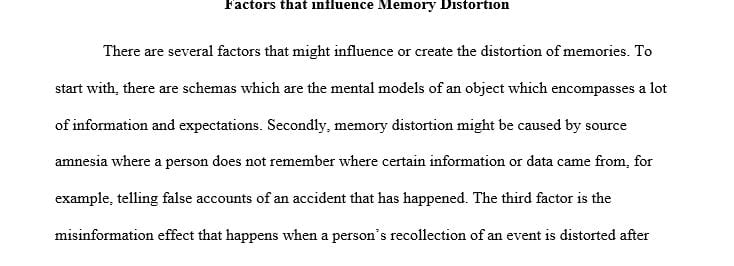Post a brief description of factors that might influence and create distortions of memory.
In this Discussion, you examine factors that might influence and create distortions of memory. You also explain potential consequences of memory distortion on eyewitness testimony.
With these thoughts in mind:
Post a brief description of factors that might influence and create distortions of memory. Then explain how one of those factors might create a memory distortion. Provide an example to support your response. Finally, explain three consequences of memory distortion in the context of eyewitness testimony. Justify your response using the Learning Resources and current literature. (500 words or more)
Be sure to support your postings and responses with specific references to the Learning Resources.
READINGS
Meegan, D. V. (2008). Neuroimaging techniques for memory detection: Scientific, ethical, and legal issues. The American Journal of Bioethics, 8(1), 9–20.
Retrieved from the Walden Library databases.
Schiller, D., Monfils, M. H., Raio, C. M., Johnson, D. C., Ledoux, J. E., & Phelps, E. A. (2010). Preventing the return of fear in humans using reconsolidation update mechanisms. Nature, 463(7277), 49–53.
Retrieved from the Walden Library databases.
Watson, J. M., Bunting, M. F., Poole, B. J., & Conway, A. R. (2005). Individual differences in susceptibility to false memory in the Deese-Roediger-McDermott paradigm. Journal of Experimental Psychology: Learning, Memory, and Cognition, 31(1), 76–85.
Retrieved from the Walden Library databases.
Loftus, E. F., & Davis, D. (2006). Recovered memories. Annual Reviews of Clinical Psychology, 2, 469–498.
Loftus, E. F., & Davis, D., Recovered Memories, Annual Reviews of Clinical Psychology. Copyright 2006 Annual Reviews, Inc. Used with permission from Annual Reviews, Inc. via the Copyright Clearance Center.
Schacter, D. L., & Addis, D. R. (2007). The cognitive neuroscience of constructive memory: Remembering the past and imagining the future. Philosophical Transaction of the Royal Society of London B: Biological Sciences, 362(1481), 773–786.
The cognitive neuroscience of constructive memory: Remembering the past and imagining the future by Schacter, D., & Addis, D. in Philosophical Transactions of the Royal Society. Copyright 2007 by The Royal Society. Reprinted by permission of The Royal Society via the Copyright Clearance Center.
MEDIA
Laureate Education, Inc. (Executive Producer). (2012). Long-term memory [Interactive multimedia]. Baltimore, MD: Author.
Answer preview to post a brief description of factors that might influence and create distortions of memory. 
APA
686 ords



